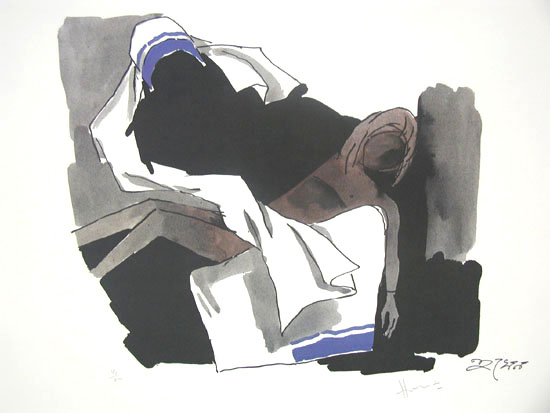|
| |
| MAQBOOL FIDA HUSAIN (1915 – 2011) |
 |
|
Mother Theresa Holding the Child
17 x 22 in.
Signed Framed Serigraph
ND
$1,000-1,500 |
|
|
|
| Artist Bio |
Born on September 17, 1915, in Pandharpur, Maharashtra, India.
Commonly known as M.F., Husain was an eminent Indian painter. Widely regarded as the "Picasso of India," he is arguably the most recognizable figure of modern and contemporary Indian art, influencing a whole generation of artists in the country. A self-taught artist, Husain moved to Mumbai at an early age and began his artistic career by painting the billboards for cinemas. He recalled, "We were paid barely four or six annas per square foot. That is, for a 6x10 feet canvas, we earned a few rupees. And apart from the New Theatre distributor, the others did not pay us at all. As soon as I earned a little bit, I used to take off for Surat, Baroda and Ahmedabad to paint landscapes."
Husain became associated with Indian modernism in the 1940s. A dashing, highly eccentric figure dressed in impeccably tailored suits, he went barefoot and brandished an extra-long paintbrush as a slim cane. He never maintained a studio, but he spread his canvases out on the floors of whatever hotel room he happened to be staying in, always paying for damages when he checked out. He created four museums to showcase his work, and had a collection of classic sports cars. Enormously prolific, a gifted self-promoter and hard bargainer, he claimed to have produced some 60,000 paintings. When questioned about such prolificacy by Michael Peschardt of the BBC in one of the last interviews he gave on May 27th 2011, he replied, "All this talk about inspiration and moment is nonsense. Excuse us". He amassed a fortune, but maintained a bank balance of zero. He applied the formal lessons of European modernists like Cézanne and Matisse to scenes from national epics like the Mahabharata and Ramavana, to the Hindu pantheon.
His first exhibition took place in 1947 with his painting Sunhera Sansaar, shown at the annual exhibition of the Bombay Art Society, and Husain decided to stay in India during the Partition in 1947. Between 1948 and 1950, Husain's work caught the public eye in a series of exhibitions across India. Through the fifties and sixties, he traveled outside India, with his first foray into China in 1951. The following year, he had his first solo exhibition in Zurich, and so began a series of exhibitions across Europe and the United States. In 1966, the Government of India awarded him the Padmashree.
Over the following decades, Husain's fame spread and was glorified by what was deemed to be a rather controversial approach to his art. His Shwetambari exhibition at the Jehangir Art Gallery consisted of two halls shrouded in white cloth, whorls of which also shared the floor with torn newspapers. Later, he gave a public performance at the Tata Center in Calcutta. For several days, a crowd watched as he painted pictures of six goddesses. On the last day of the exhibition, he destroyed his paintings by over-painting them in white. Several of his paintings in the 1990s were named after the film actress Madhuri Dixit, perhaps displaying a childhood obsession originating from his time spent painting billboards. As reported in The Times of India, "The Padma Vibhushan awardee continues to paint events that are topmost on contemporary minds, be it the solar eclipse, the cricket mania or the victory at Kargil."
Themes in Husain's work often returned to his cultural roots, but he embraced diverse influences - from the cinematography of Buńuel, to themes that have blended folk, tribal and mythological figures - to create vibrantly contemporary, living art forms in his work.
Icons of Indian culture through the ages seek to capture the quintessence of his subjects, like Mother Teresa and Gandhi, to religious icons as Krishna and Saraswati.
His narrative paintings, executed in a modified Cubist style, can be caustic and funny as well as serious and somber. His themes-usually treated in series-also include hallmarks of Indian culture and history, such as the Ramayana, the Mahabharata, the British Empire, and motifs of Indian urban and rural life. One of the most celebrated and internationally recognized Indian artists of the 20th century, he also received recognition as a printmaker, photographer, and filmmaker.
Besides painting, he also made feature films, including Through the Eyes of a Painter (1966), which won the 'Golden Bear Award' at the Berlin Film Festival (1967), and was also awarded the 'Gaja Gamini' in 2000. The Government of India honored him with the 'Padma Bhushan' and the 'Padma Vibhushan' awards, both prestigious civilian awards. In 2007, Husain received Honorary Doctorates from Benaras Hindu University, Jamia Millia Islamia University, and Mysore University.
The artist passed away on June 9th 2011 in London, UK. However, his vast artistic legacy lives on around the world.
|
| |
|
|

